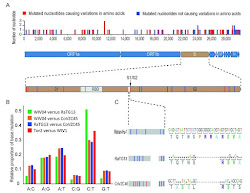Variants of co-habitant inside ‘SARS-CoV-2’ get its Greek letter-based novel nomenclature by WHO
The on-going pandemic spread of the virus ‘SARS-CoV-2’ resulted in the generation of thousands of its genome sequences across the globe. And so, with its unparalleled rate of growth, scientists, researchers and global health leaders felt the need of having a proper phylogenetic framework in order to track and understand the gravity, patterns and determinants of the fatality imposed by the virus on the population all over the world.
At present, there are over 35,000 genome sequences that have
either a complete or near complete genome sequences of SARS-CoV-2. So, let us
talk about the definition of genome structure of the virus first. What does a virus
genome made of? Well, the virus genome consists of symmetric protein called as ‘capsid’,
which is composed of either a single or a multiple protein. The virus can have either
a DNA or an RNA- based genome, respectively. So, a virus genome alters through
the process of mutation by changing a few genetic letters by infecting more
people at different places over a period of time and thus changes its genome
sequences from its previous structure.
Hence, in order to know the actual phylogenetic framework, a
clear and concise naming system must be at place to erase any kind of confusion
over the names of the variants during the research happening at the laboratories
across the world. In case of viral nomenclature system, scientists usually
follow the pattern of ‘Genetic Distance Threshold’
to classify the variants, their nature and impact on the population over a
period of time. The way we normally categorise a region by its specific pin
code, locality, area on a map to reach the destination, we follow the same
pattern in the case of a virus. Additionally, it also facilitates in bringing out the real
time epidemiology with the use of labels that are commonly accepted worldwide
and thankfully, the root sequencing of the genome of SARS-CoV-2 was generated at
an early stage because of the quick sampling of COVID-19 in Hubei province of
China.
The World Health Organisation with its partners and experts
based at several global institutions and organisations had continuously been
monitoring and assessing the evolution of SARS-CoV-2 since January 2020, where,
they identified the emergence of certain variants creating life-threatening
situation to the global health. The WHO, then named these emergent as VOC and
VOI (Variants of Concern & Variants of Interest) respectively.
Further, as per the definition found on WHO’s website, a newly emerged variant of an existing virus that has already shaped a life-threatening risk across the globe should have met the following patterns to be called as ‘Variants of Concerns’ - a) increase in transmissibility or detrimental change in COVID-19 epidemiology; b) increase in virulence or change in clinical disease presentation; and c) decrease in effectiveness of public health and social measures or available diagnostics, vaccines and therapeutics.
To be found as ‘Variants of Interests’, a newly emerged variant according to the World Health Organisation must have been identified to cause community transmission/multiple COVID cases/cluster or has been detected in multiple countries or is otherwise assessed to be a VOI by the WHO in consultation with the WHO SARS-CoV-2 Virus Evolution Working Group.
With the help of studies conducted by the open source initiatives-
GISAID, Nexstrain and Pango on the genetic lineage of SARS-CoV-2, the
representatives of these groups and other experts put forward their
recommendation of using letters in Greek alphabet- Alpha, Beta, Gamma, and
Delta to label the newly-found variants to develop a comprehensive
understanding of their impact on the masses.
Viruses and diseases are named to facilitate the development of several vital diagnostics tests and to generate vaccines and medicines to reduce the impact and severity of the disease. Viruses are named by ICTV popularly known as the International Committee on Taxonomy of Virus, whereas diseases are generally classified and named by ICD, the International Classification of Diseases.
SARS-CoV-2 was announced as novel virus by the ICTV on January 11th 2020 because of its genetic similarity with other coronaviruses that caused the outbreak of SARS in the year 2003, however, on the same day, 11th January 2020, the World Health Organisation had announced, COVID-19 as a new disease that took over three and a half millions of lives worldwide.
By- Rashmi Singh
#COVID19 #SARSCoV2 #NewVariants #NewLabeling #Nomenclature #WHO #GreekLetters #GeneticDistanceThreshold #PublicHealthEmergency #VOCs VOIs




.jpg)

Comments
Post a Comment